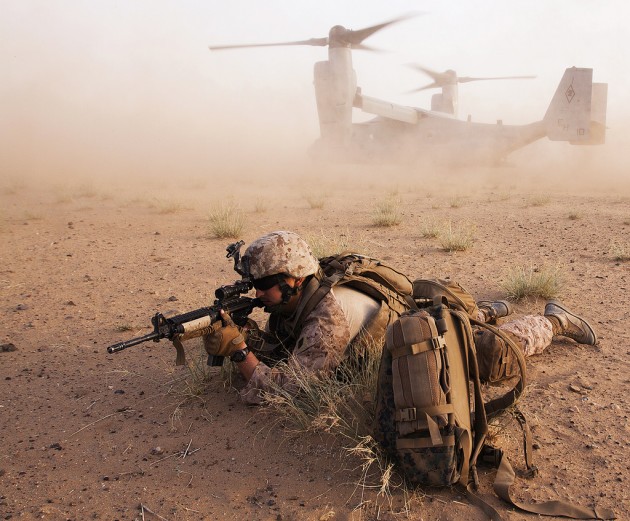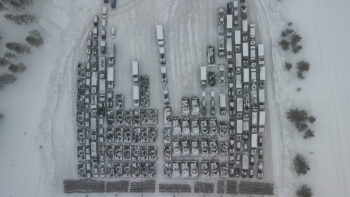 BALLSTON, Va: Since early November, three Marine Corps MV-22B Ospreys and 26 marines have been on alert at Al Jaber Air Base in Kuwait, on 30-minute alert to fly in and rescue a U.S. or coalition pilot downed while bombing or shooting at the Islamic State in Iraq or Syria. On 29 occasions between Nov. 1 and April 24, two Ospreys and a KC-130J aerial refueling tanker assigned to this Tactical Recovery of Aircraft and Personnel (TRAP) mission have spent 145 hours loitering in the air as large coalition airstrikes were underway, “ready to swoop in if required,” their former commander says.
BALLSTON, Va: Since early November, three Marine Corps MV-22B Ospreys and 26 marines have been on alert at Al Jaber Air Base in Kuwait, on 30-minute alert to fly in and rescue a U.S. or coalition pilot downed while bombing or shooting at the Islamic State in Iraq or Syria. On 29 occasions between Nov. 1 and April 24, two Ospreys and a KC-130J aerial refueling tanker assigned to this Tactical Recovery of Aircraft and Personnel (TRAP) mission have spent 145 hours loitering in the air as large coalition airstrikes were underway, “ready to swoop in if required,” their former commander says.
Their one shot at a rescue didn’t happen, but not for lack of trying. “Luckily, God willing, we did not have to bring anybody out because the only pilot that went down was the Jordanian,” Marine Col. Jason Bohm told an audience at the Potomac Institute. (Bohm just returned from Iraq on April 24.) “Unfortunately, he did not have his radio on him when he ejected (emphasis added), and as we saw on TV, he landed very close to a Daesh position.” Daesh, an Arabic acronym, is one of several for ISIL, also known as Islamic State.
The TRAP team is a small part of the newly created Special Purpose Marine Air Ground Task Force Crisis Response Central Command (unwieldy acronym SP-MAGTF-CR-CC) that Bohm led in its inaugural deployment. The new Central Command MAGTF, which Bohm’s 5th Marine Regiment relinquished to the 7th Marine Regiment, is modeled on a similar unit created for Africa Command after the September 2012 attacks on U.S. diplomatic and CIA compounds in Benghazi. In essence, the new Special Purpose MAGTFs are landborne Marine Expeditionary Units.
Bohm’s unit included 2,300 marines with their own air forces, as is standard for a Marine unit: Medium Tiltrotor Squadron 363 (VMM-363) with a dozen MV-22Bs; six EA-6B Prowler electronic warfare jets; Marine Attack Squadron 211 (VMA-211) with a dozen AV-8B Harrier vertical takeoff attack jets; four KC-130J aerial refueling tankers.
Established to respond to crises of any kind, Bohm’s MAGTF has spent much of its time on Operation Inherent Resolve, the U.S.-led air campaign against ISIL. The MAGTF’s Harriers, operating out of Bahrain’s Sheik Isa Air Base “were bombing Daesh nonstop,” Bohm said. MAGTF Marines also used data from Air Force MQ-1 Predators and their own unit of RQ-7 Shadow drones to guide air strikes by Marine and other U.S. and coalition aircraft.Those Harriers accounted for 50 percent of the estimated 600-plus Islamic State fighters, 60 enemy fighting posts, and 100-plus vehicles – largely boats on the Euphrates River – destroyed in air strikes conducted or guided by the MAGTF.

Marines board an MV-22B at Al Asad, Iraq, Dec. 9, 2007. Photo by Richard Whittle
MAGTF marines are also training Iraq’s 7th Division at Al Asad Air Base, just 50 miles from Ramadi, the town most recently infested with ISIL troops in Anbar Province.
“When you look at the news reports that are coming out and you see the waves of red (representing Islamic State control) that are going down the Euphrates River valley, there’s a gap in that red, and it’s right there where Al Asad is located,” Bohm said.
“Daesh has not taken over Al Asad.” But Bohm also said the Iraqi forces there “are tired and they’ve been attrited. They’ve been in sustained combat for 10 months now and they were not at full strength when the war began.” But U.S. forces are limited in how they can help. None are fighting “outside the wire,” Bohm said, at Al Asad or elsewhere.
When I visited Al Asad air base in 2007 while working on my book about the V-22 Osprey, it was a comfy place – nicknamed “Camp Cupcake,” and a very safe place to be. When Bohm arrived there last fall, three years after U.S. forces relinquished the base to Iraq, Al Asad was “like a scene out of the Twilight Zone,” he said. “Our headquarters was a former Marine air logistics squadron headquarters. There were items that were just left there when we picked up and left. Literally newspapers with the date the last person that was in that office (departed are) still there, except there’s a lot of dust on it now.”
Bohm made crystal clear the choices the Obama administration has made in limiting the role of US forces in Iraq this time around: “Could we put the 1st Marine Division on line and clear through Iraq? Yes, we could. Our administration has made the decision that it was not going to do that. We were going to enable and facilitate the Iraqis to do it for themselves — with a lot of support from us.”
Sullivan: Defense industry ‘still underestimating’ global need for munitions
National Security Advisor Jake Sullivan said that there are “no plans” for another Ukraine supplemental at this point.


























